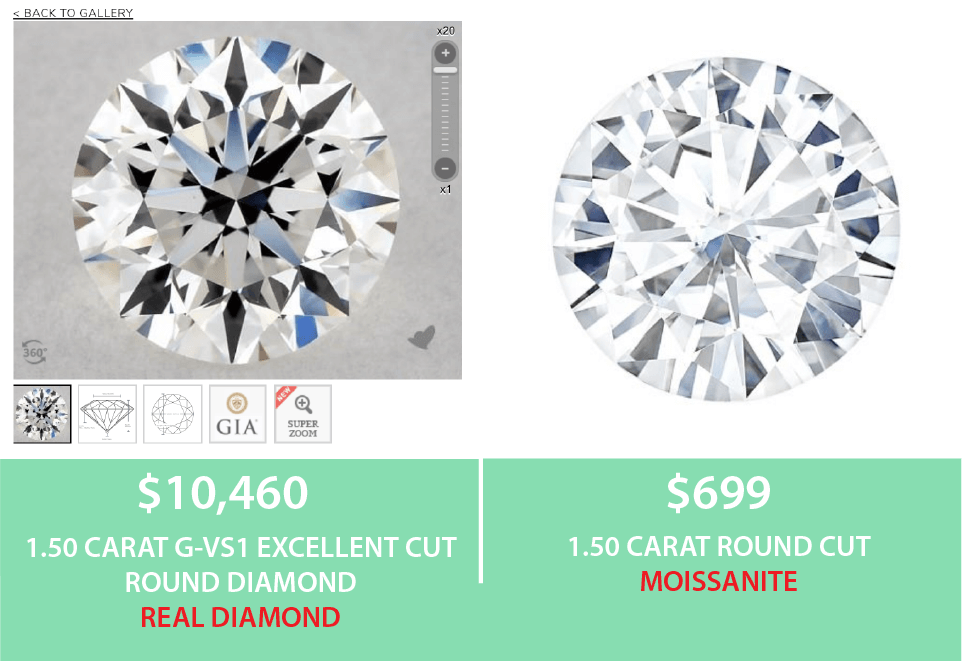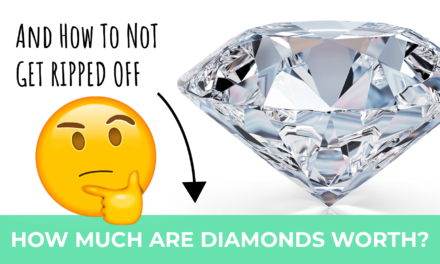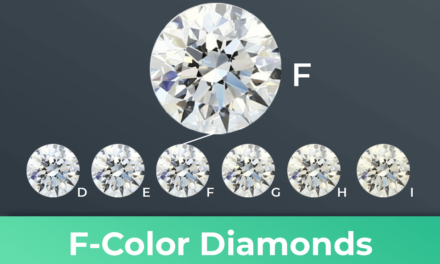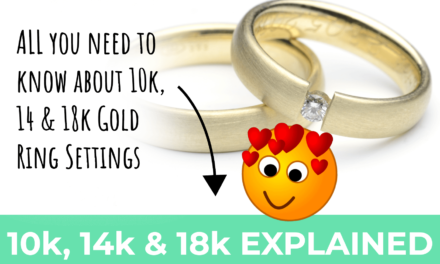My website is reader-supported. Buying through links on my site may result in me earning a CUSTOMER REFERRAL FEE at no extra cost to you.
Check out the latest deals at our top diamond vendor choice: James Allen
Moissanite vs Diamond – A Worthy Diamond Alternative?
When comparing moissanite vs diamonds, it is best to start with a little bit of history. Unlike diamonds, which have known for about 3000 to 6000 years, moissanite gems have been known for less than 200 years.

What many people don’t know is that they actually come from the stars: In the late 19th century, a meteor dropped to earth and a person named Henri Moissan was lucky enough to be able to examine it. He later won a Nobel prize for it, despite initially thinking he was holding diamonds in his hands.
In reality, he was holding a naturally occurring mineral, also known as silicon carbide. Silicon carbide is usually only found in meteors dropping on earth.
What he and the other scientists found was soon to be called moissanite, an extremely rare and hard stone. Because of its rarity, most moissanite is now lab-created. Just like lab created diamonds.
In this blog post, we are comparing the different characteristics of the moissanite and natural diamonds which differ in several aspects such as price, color, durability, and brilliance. We will also discuss whether moissanite rings are a good alternative for engagement rings.
In this post we’ll cover:
- Moissanite vs diamond side by side
- Moissanite vs diamond price
- Diamond vs moissanite durability
- The brilliance and fire of natural diamonds vs moissanite gems
- Compare diamonds and moissanite in color
- Interesting cut and carat differences
- Clarity comparison
- Grading comparison
- Difference between a forever brilliant moissanite and a forever one
- Where to buy a moissanite?
- Is moissanite a good alternative to diamonds for engagement rings?
Moissanite vs diamond side by side
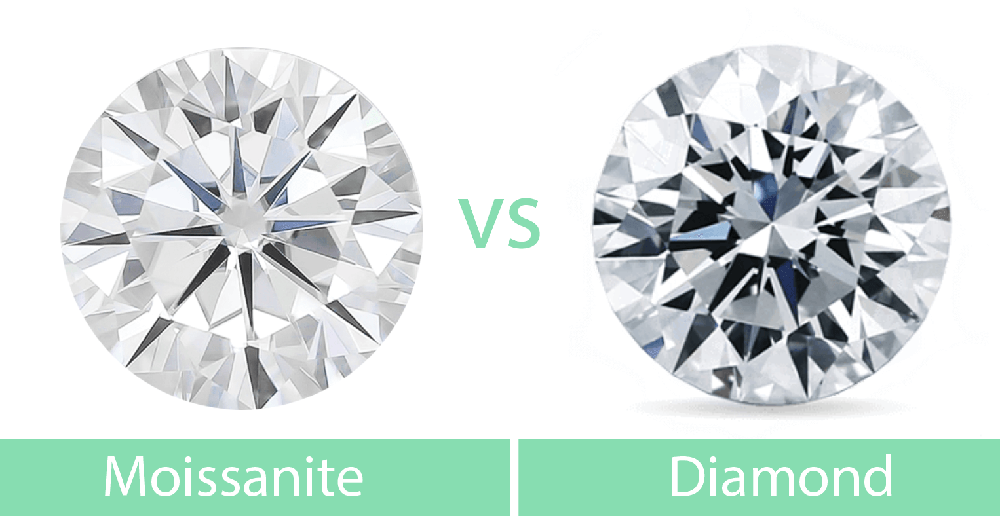
Moissanite vs Diamond Price
Natural moissanite, just like a lab-created diamond, is a great alternative for people who want to save money. When comparing moissanite with a diamond side by side, it’s hard to tell which one is more beautiful. They do differ significantly though in their price point.
On average, a naturally occurring moissanite stone of comparable weight to a diamond costs only 10% of the price of a diamond. If we are talking about a 1-carat moissanite stone, you will pay around $380 to $500. A one carat diamond costs more than any other gemstone out on the market.
A diamond’s price varies based on color, clarity, carat and cut grades. A one carat diamond would cost between $3,800 to $5,000 if you buy it online. If you bought it from an offline vendor, you would pay even more. Hence, you are able to afford a larger stone with higher carat weight.
Even though lab grown diamonds are cheaper than a “real diamond”, you’d still save a substantial amount of money when choosing a moissanite center stone instead.
Furthermore, there are different ways to save money on a diamond without compromising on quality or beauty. For one, it is much cheaper to buy a diamond online as online retailers have lower operating costs and, therefore, can sell a diamond for less to you.
Secondly, you can save a lot of money if you know which color and clarity grade to get. Most people think that they have to get the highest clarity and color grade to get a great looking diamond. Consequently, they pay a hefty premium.
Moissanite vs Diamond Durability
Moissanite is not the hardest known mineral on earth, but it comes pretty close. On the Mohs Scale, which describes the hardness of substances, it receives a score of 9.25 to 9.5 out of 10. As a comparison, steel only receives a score of 4 to 4.5.
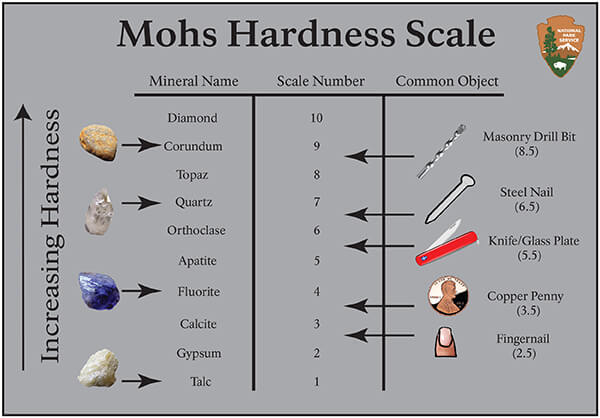
Its exceptional hardness makes it harder than any other gemstone, except for diamonds, of course. Thanks to its hardness, it is very resistant to scratches, heat, and any other signs of everyday wear.
Unlike moissanite, a diamond is the hardest substance on earth. On Mohs Scale, which classifies substances based on their hardness, a diamond receives a score of 10 out of 10.
Thanks to its hardness, it is impossible to find scratches on a diamond. A diamond will keep its beauty forever. Some people say that’s what makes it the perfect gemstone for an engagement ring, symbolizing a love that will last forever, as well.
The brilliance and fire of natural diamond vs moissanite gems
Brilliance refers to the stone’s ability to reflect light. It determines how much the gem will sparkle. The brilliance a diamond exhibits is influenced by several factors, such as color-grade and cut grade. Moissanite is not so much affected by these factors.
When comparing the two gems, moissanite actually sparkles more than a diamond. While some people prefer more sparkle, others don’t.
The huge amount of sparkle makes the moissanite look somewhat unnatural. As a side note: The same applies to cubic zirconia. But unlike cubic zirconia, moissanite jewelry has a bit more of an expensive look.
For comparison: a diamond has a brilliance refractive index of 2.42, moissanite has a higher index of 2.65, and sapphire has a lower index of 1.77
In general, a diamond is one of the few stones on this earth that naturally sparkle, which makes them, without doubt, look very beautiful.
Compare diamonds and moissanite in color
Near colorless moissanite is very common as it is its natural color. A colorless moissanite resembles a k-color diamond, and under certain light conditions sometimes appears yellow-green. The color will not change over time.
The most popular diamond choice is a colorless diamond. The color of a diamond is graded based on how clear or colorless the diamond is. Diamonds with low color grades such as appear to be yellow or brown.
Interesting cut & carat differences
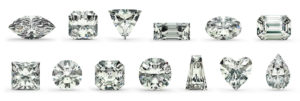
However, unlike diamonds, jewelers do not care about how much a moissanite stone weights. That’s because we don’t measure a moissanite in carat. Hence, they will always choose the better cut.
Besides brilliant cut moissanite stones, you will also find other popular cuts and shapes, such as oval moissanite cuts or princess cuts.
The most popular diamond cut is the brilliant-cut diamond which is graded by the GIA and AGS. A perfect cut helps the diamond to exhibit the most amount of sparkle.
Sometimes jewelers decide to choose a lower cut grade in order to retain the most amount of weight.
Clarity comparison
Moissanite stones do have inclusions. However, they are so tiny that you will not be able to see them with the naked eye.
One reason they hardly have any visible inclusions is that they are lab-grown, which of course, also helps to substantially lower the moissanite price compared to diamonds.
Almost 99.9% of all naturally occurring diamonds have inclusions and blemishes. The severity of these inclusions and blemishes is graded by the GIA and AGS. Nearly perfect diamonds with a high clarity grade are very expensive. However, you can choose lower clarity grades as most inclusions in the upper grades are so minimal that you cannot see them with the naked eye.
Grading differences
Moissanite grading uses a color grading scale that is based upon the GIA diamond color grading scale. There are three grades of moissanite available today: colorless (D-E-F range), near-colorless (G-H-I range), and with faint hues of color (J-K range).
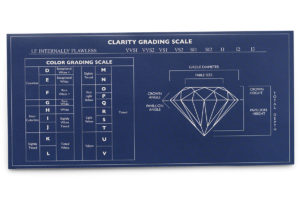
However, neither the GIA or the AGS actually issues grading reports for Moissanite stones. Neither for cubic zirconia or sapphire stones.
Diamond sold by reputable vendors always come with a GIA or AGS grading report. I recommend to never buy a diamond which comes without a valid certificate. Some vendors offer their grading reports. However, industry standards are GIA and AGS.
Professional diamond examiners, grade diamonds in four categories, which are also called the 4Cs, which is Cut, Clarity, Color, and Carat.
Difference between a forever brilliant moissanite and a forever one
When you are shopping for a moissanite, it’s important to understand the difference between the two types of moissanite.
A forever brilliant moissanite is a high-quality diamond alternative that offers all the beauty of a diamond, but at a fraction of the cost. It is up to four times brighter than other gemstones and will never lose its sparkle.
A forever one moissanite, on the other hand, is not quite as bright as a forever brilliant moissanite, but it is still significantly brighter than other gemstones. Though not when compared to a diamond!
So which should you choose? It really comes down to personal preference. If you want your moissanite to be the brightest jewel in the room, get a forever brilliant moissanite.
If you prefer something more subtle, go with a forever one moissanite. Forever Brilliant has been an industry leader since 2002 and uses only lab-created gemstones.
Both type of stones can be used in an engagement ring.
Moissanite – A Good Choice for an Engagement Ring?
Some consumers prefer diamond rings, others prefer diamond moissanite engagement rings. It really is a personal choice.. While nothing can compare to the durability and hardness of a diamond, moissanite comes pretty close. It is also considerably cheaper, which might make it an attractive choice if you are on a tight budget but still want a somewhat large stone.
On top of that, you can be sure that moissanite is not a blood diamond (unlike some mined diamonds from certain vendors). And almost anyone would agree that moissanite rings would make for a unique engagement ring.

On the other hand, you should take into account that moissanite is lab-created, which quite some people might find unromantic. In addition to that, moissanite is neither well known or popular (yet) and hence might lead to confusion for the person receiving the ring.
In my personal opinion, if the budget allows, I would always opt for a diamond. However, I do view moissanite as one of the better alternatives to real diamonds. Some people consider a moissanite ring as a fake diamond. But it is not, it’s a valid diamond simulant with its own uniqueness.
Furthermore, they have many advantages over a sapphire or zirconia stone when considered for an engagement ring. So if you want to pick an alternative to a diamond, I would recommend moissanite over sapphire or zirconia.
Where to buy a moissanite?
One of the most popular seller of moissanite is Charles Colvard. Take a look at their stones here.
In Conclusion: Moissanite vs Diamond
If you are still unsure of whether to choose a moissanite vs diamond for your engagement ring, also consider that there are some tricks on how to save money when buying a diamond ring. What many people don’t know is that you can save a lot of money when buying a diamond with a lower clarity grade and color grade without seeing a real difference with the naked eye. You might also want to consider a lab-created diamond.
Other than that, moissanite will make a beautiful center stone in an engagement ring.
In addition to that, you can save even more money when you buy a diamond online. I always recommend James Allen, as he provides 360-degree videos of each of his diamonds and also high-resolution pictures.
So, what do you prefer? Do you prefer moissanite or a diamond for fine jewelry? Let me know in the comments below! And don’t forget to check out my blog post about a lab grown diamond here.

